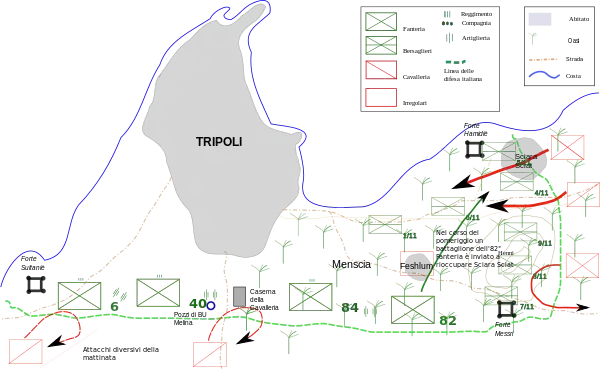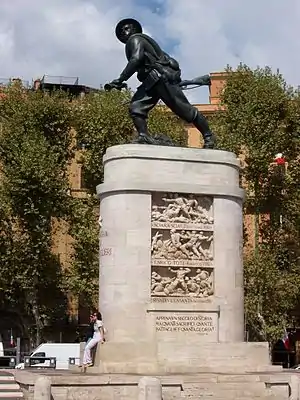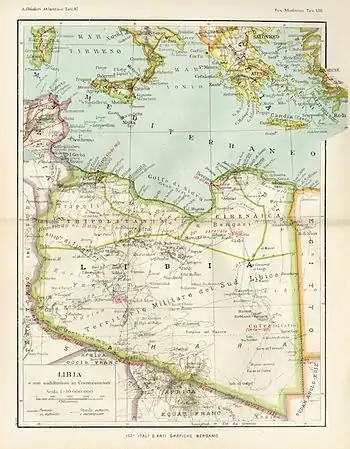Shar al-Shatt
Shar al-Shatt (Arabic: شارع الشط Shār’ ash-Shaṭ; Sciara Sciat in Italian) was the location of the "Massacre of Italians at Sciara Sciat", that occurred on October 23, 1911 in a village on the outskirts of Tripoli, Libya. According to Italian sources, 503 officers and men (light infantry, 'bersaglieri' in Italian) were killed in the incident, which occurred shortly after the beginning of the Italo-Turkish War. It was the biggest loss of life for Italian troops prior to World War I.[1]

History
The Italian fleet appeared off Ottoman Tripoli on the evening of September 28, 1911; the city was quickly conquered by 1,500 Italian sailors, who were initially welcomed by the population.
Despite the quick Italian conquest of the city of Tripoli and surroundings from the Ottoman Empire by the first days of October, the interior of Ottoman Libya shortly broke out into revolt, with Italian authorities losing control over large areas of the region.
Indeed, even before the arrival of the Italian forces, cells led by Ottoman officers (called "Young Turks", like Kemal Atatürk) encouraged native Libyans to infiltrate Italian-owned industries and companies in Tripolitania, reconnoiter roads, and take a census of all males able to bear arms in Tripoli and Derna, in preparation for a jihad of the local Muslims.
Even though the Arab (and Jewish) population of the city of Tripoli welcomed the Italians, the interior of Tripolitania rose in revolt from the first weeks and atrocities were committed against the Italian soldiers and civilians by local Muslims (supported by Turkish officers disguised as Arabs), as happened in Shar al-Shatt.[2]
The IV Battalion of the 11th Bersaglieri Regiment of Colonel Gustavo Fara had been positioned at the small oasis village as part of the defenses of Tripoli. On October 23 the force of about five hundred soldiers came under attack from the Turks and Arabs and was quickly overrun and decimated. Approximately 290 'bersaglieri' who survived the initial assault surrendered to the jihadists in the local cemetery, but all were tortured and killed.
I saw (in Sciara Sciat) in one mosque seventeen Italians, crucified with their bodies reduced to the status of bloody rags and bones, but whose faces still retained traces of their hellish agony. Long rods had been passed through the necks of these wretched men and their arms rested on these rods. They were then nailed to the wall and died slowly with untold suffering. It is impossible for us to paint the picture of this hideous rotted meat hanging pitifully on the bloody wall. In a corner another body was crucified, but as an officer he was chosen to experience refined sufferings. His eyes were stitched closed. All the bodies were mutilated and castrated; so indescribable was the scene and the bodies appeared swollen as shapeless carrion. But that's not all! In the cemetery of Chui, which served as a refuge from the Turks and to whence soldiers retreated from afar, we could see another show. In front of one door near the Italian trenches five soldiers had been buried up to their shoulders, their heads emerged from the black sand stained with their blood: heads horrible to see and there you could read all the tortures of hunger and thirst. Gaston Leroux, correspondent of "Matin-Journal"[3]
Argentine journalist Enzo D'Armesano of the Buenos Aires newspaper "La Prensa" was present the next morning in Shar al-Shatt and reported the cruelty with a description that impressed the Argentinian people. He reported that many local civilians approached the Italians' lines from behind, initially showing friendship, only to fall upon them with knives. He wrote that the only three survivors of the 4th Battalion accused the Arab civilians of the Shar al-Shatt oasis of "tradimento" (betrayal)[4]
Aftermath

Officially 21 Italian officers and 482 soldiers died at Shar al-Shatt, 290 of them massacred after surrender in the cemetery[5]
In 1932 Mussolini inaugurated a monument to the Bersaglieri in Rome, especially honoring those who died at Shar al-Shatt. The monument was designed by architect Italo Mancini and was created by sculptor Publio Morbiducci.[6]
See also
Notes
- Gerwarth, Robert; Manela, Erez (2014-07-03). Empires at War: 1911–1923. OUP Oxford. p. 37. ISBN 978-0-19-100694-4.
- Cronaca e storia del corpo dei Bersaglieri, 1836–1986 (in Italian). Piazza. 1986. p. 173. OCLC 219933820.
- Gaston Leroux, Matin Journal edition August 23, 1917
- de Martino, Antonio (1911). Tripoli italiana: la guerra italo-turca. Società libraria italiana. pp. 116–118.
- Childs, Timothy Winston (1990). Italo-Turkish Diplomacy and the War Over Libya: 1911–1912. BRILL. p. 86. ISBN 90-04-09025-8.
- Painter, Borden (2007). Mussolini's Rome: Rebuilding the Eternal City. Palgrave Macmillan. p. 134. ISBN 978-1-4039-8002-1.
Bibliography
- Childs, Timothy Winston (1990). Italo-Turkish Diplomacy and the War Over Libya: 1911–1912. BRILL. ISBN 90-04-09025-8.
- de Martino, Antonio (1911). Tripoli italiana: la guerra italo-turca. Società libraria italiana.
- Gerwarth, Robert; Manela, Erez (2014). Empires at War: 1911–1923. OUP Oxford. ISBN 978-0-19-100694-4.
- Painter, Borden (2007). Mussolini's Rome: Rebuilding the Eternal City. Palgrave Macmillan. ISBN 978-1-4039-8002-1.
